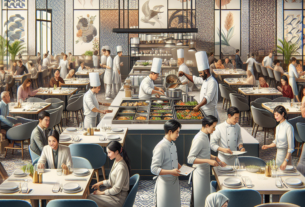The Role of Predictive Analytics in Foodservice
The Current State of the Foodservice Industry
The foodservice industry is a dynamic and ever-evolving sector that encompasses a wide range of businesses, including restaurants, cafes, catering services, and food trucks. In recent years, the industry has faced numerous challenges, including changing consumer preferences, increasing competition, and rising costs. As a result, many businesses in the foodservice industry have turned to technology to help them stay ahead of the curve.
Market Share and Financials
According to a report by Market Research Future, the global foodservice market is expected to reach $4.2 trillion by 2025, with a CAGR of 4.2% from 2020 to 2025. The market is highly fragmented, with a large number of small and medium-sized businesses competing for market share. Some of the key players in the industry include McDonald’s, Yum! Brands, Starbucks, and Darden Restaurants.
In terms of financials, the foodservice industry has seen steady growth over the past few years, with many companies reporting strong revenue and profit margins. However, the industry is also facing challenges, such as rising labor costs, supply chain disruptions, and changing consumer preferences. As a result, many businesses are turning to predictive analytics to help them navigate these challenges and stay competitive.
What is Predictive Analytics?
Predictive analytics is a branch of advanced analytics that uses data, statistical algorithms, and machine learning techniques to identify the likelihood of future outcomes based on historical data. In the context of the foodservice industry, predictive analytics can help businesses forecast demand, optimize pricing, improve inventory management, and enhance customer experience.
Benefits of Predictive Analytics in Foodservice
There are several key benefits of using predictive analytics in the foodservice industry. These include:
1. Demand Forecasting: Predictive analytics can help businesses accurately forecast demand for their products and services, allowing them to optimize production schedules, reduce waste, and improve profitability.
2. Pricing Optimization: By analyzing historical sales data and market trends, businesses can use predictive analytics to optimize pricing strategies, maximize revenue, and stay competitive in a crowded market.
3. Inventory Management: Predictive analytics can help businesses optimize their inventory levels, reduce stockouts, and minimize excess inventory, leading to cost savings and improved efficiency.
4. Customer Experience: By analyzing customer data and behavior, businesses can use predictive analytics to personalize marketing campaigns, tailor product offerings, and enhance overall customer experience.
Case Study: How a Restaurant Chain Used Predictive Analytics to Drive Sales
One example of a company that successfully leveraged predictive analytics in the foodservice industry is a national restaurant chain. The company had been struggling with declining sales and rising costs, leading to concerns about its long-term viability. In response, the company implemented a predictive analytics solution to help them better understand customer preferences, optimize menu offerings, and improve operational efficiency.
By analyzing customer data, transaction history, and market trends, the company was able to identify key drivers of sales and develop targeted marketing campaigns to attract new customers and retain existing ones. The predictive analytics solution also helped the company optimize menu pricing, reduce waste, and streamline inventory management processes.
As a result of these efforts, the company saw a significant increase in sales, improved customer satisfaction, and higher profitability. The company’s management team credited predictive analytics with helping them make data-driven decisions, identify new growth opportunities, and stay ahead of the competition in a challenging market.
The Future of Predictive Analytics in Foodservice
Looking ahead, the role of predictive analytics in the foodservice industry is expected to continue to grow in importance. As businesses face increasing competition, changing consumer preferences, and evolving market dynamics, predictive analytics will become an essential tool for driving growth, improving operational efficiency, and enhancing customer experience.
Some of the key trends shaping the future of predictive analytics in the foodservice industry include the use of artificial intelligence and machine learning algorithms, the integration of data from multiple sources, and the adoption of real-time analytics capabilities. By leveraging these technologies and best practices, businesses in the foodservice industry can gain a competitive edge, drive innovation, and thrive in an increasingly digital and data-driven world.
In conclusion, predictive analytics plays a crucial role in helping businesses in the foodservice industry navigate challenges, seize opportunities, and achieve sustainable growth. By harnessing the power of data and analytics, businesses can make informed decisions, drive operational excellence, and deliver exceptional customer experiences. As the industry continues to evolve, predictive analytics will be a key differentiator for businesses looking to stay ahead of the curve and succeed in a competitive marketplace.
[read_more] Source: CulinaryCoverage.com
[/read_more]



